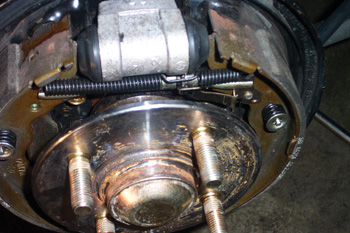When a customer purchases new brake pads or shoes for their vehicle, they often overlook the hardware in the brake system that supports the calipers and pads. Anti-rattle shims and springs also help dampen noise-producing vibrations when the brakes are applied. If the vehicle has drum brakes at the rear, the hardware inside the drums positions and retracts the shoes and helps maintain proper shoe adjustment.
 Brake hardware should always be inspected and replaced as needed because worn, loose, badly corroded or missing hardware can prevent the brakes from operating properly. New brake hardware is recommended for high-mileage vehicles when the brakes are re-lined.
Brake hardware should always be inspected and replaced as needed because worn, loose, badly corroded or missing hardware can prevent the brakes from operating properly. New brake hardware is recommended for high-mileage vehicles when the brakes are re-lined.
The shoes inside a rear drum brake are held in place by “hold-down springs,” which are small coil springs secured by a pin that extends through the backing plate and locks into a cover piece that fits over the top of each spring. If the hold-down springs and pins are badly corroded, they may break or fall apart. The loose pieces will then rattle around inside the drum, creating noise, possibly scoring the drum and/or wedging between the shoes and drum causing the brake to seize.
Also attached to each shoe are two or more relatively stiff “return springs.” The return springs pull the shoes back away from the drum when the brakes are released. Over time, these springs may weaken and allow the brakes to drag.
A “self-adjuster” inside the drum brake maintains proper clearances between the shoes and drum. If a self-adjuster is corroded or sticks, it won’t compensate for lining wear and will cause brake pedal travel to increase.
Note: self-adjusters are usually directional and are not interchangeable left-to-right. If installed on the wrong side, the self-adjuster will not work properly.
Additional drum hardware may include a cable linkage for the self-adjuster and/or parking brake lever and an additional return spring for the parking brake mechanism.
Disc brake hardware includes the slides, pins, boots and bushings that allow a “floating” (sliding) caliper to center itself over the rotor, the “anti-rattle” springs that dampen pad vibrations to reduce brake noise, and any additional shims or insulators that may be used on the back of the pads for additional noise control.
When the pads and/or calipers are replaced, the caliper mounts, slides, bushings or pins should all be carefully inspected and lubricated to assure smooth operation. If your customer doesn’t have brake grease, be sure to sell him some.
Loose, missing, corroded or damaged hardware can also contribute to disc brake noise problems. If the anti-rattle clips, shims or insulators that go on the backs of the pads are overlooked or forgotten, the pads may rattle and vibrate when the brakes are applied causing an annoying squeal.













